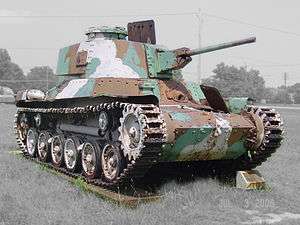Type 97 ShinHoTo Chi-Ha
| Type 97 ShinHoTo Chi-Ha | |
|---|---|
|
Type 97 Shinhoto Chi-Ha on display at the United States Army Ordnance Museum in Aberdeen | |
| Type | Medium tank |
| Place of origin | Empire of Japan |
| Production history | |
| Designed | 1939-1941 |
| Number built | 930[1] |
| Specifications (Type 97-Kai as of 1942[2]) | |
| Weight | 16 tonnes (18 tons) |
| Length | 5.50 metres (18 ft 1 in) |
| Width | 2.33 metres (7 ft 8 in) |
| Height | 2.38 metres (7 ft 10 in) |
| Crew | 5 (Commander, Gunner, Loader, Bow Gunner, Driver) |
|
| |
| Armor |
Turret front: 33 mm Turret sides: 26 mm Hull front: 25 mm Hull sides: 26 mm Hull rear: 20 mm[3] |
Main armament | 1 x Type 1 47 mm tank gun |
Secondary armament | 2 x 7.7 mm Type 97 machine guns |
| Engine |
Mitsubishi SA12200VD air-cooled V-12 diesel (21.7 litres) 170 hp (125 kW) at 2000 rpm |
| Suspension | Bell crank |
Operational range | 210 km |
| Speed | 38 km/h (24 mph) |
The Type 97 ShinhoTo Chi-Ha was a Japanese medium tank used in World War II that was an upgrade to the original Type 97 Chi-Ha. The new version was designated Type 97-Kai ("improved") or Shinhoto Chi-Ha ("new turret" Chi-Ha). This design was probably the best tank Japan produced in any large quantity up to 1945.
Development
Japanese Army observers had watched tank developments in Europe and studied as avidly as any European military the operational experiences gained by German, Soviet, and Italian tanks in the Spanish Civil War (1936-1939). In order to improve the anti-tank capability of the Type 97 Chi-Ha, a new enlarged three-man turret armed with a high-velocity 47 mm gun was combined with the Chi-Ha's hull; hence the new name Kai ("improved") or ShinHoTo ("New Turret").[4] In 1942, it replaced the original model Type 97 in production. In addition "about 300" of the Type 97 tanks with the older model turret and 57 mm main gun were converted.[5]
History
When the Type 97 entered service, properly equipped and supported mechanized infantry units were realized. The Type 97 ShinHoTo first saw action at Corregidor Island of the Philippines in 1942.[6] The Japanese commanders showed a "skillful and imaginative use of tanks" during the early string of victories of the Japanese military forces.[1] The skill with which they maneuvered their mechanized infantry divisions was best seen in Malaya, where the lighter weight of Japanese medium tanks allowed for a rapid ground advance so heavily supported by armor that British defenders never had a chance to establish effective defense lines.
While vulnerable to opposing Allied tanks (US M3 Lee/British M3 Grant, M4 Sherman and Soviet T-34), the 47 mm high-velocity gun did give the Type 97 ShinHoTo a fighting chance against them. The 47 mm gun was effective against light tanks and against the sides and rear of the Sherman tank.[7] For this reason, some ShinHoTo Chi-Has were dug in concerned positions to ambush the American tanks and others were dug in to form the core of "strong points" both on Luzon and Iwo Jima in 1945.[8] The Type 97 ShinHoTo Chi-Ha served against allied forces throughout the Pacific and East Asia as well as the Soviets during the July-August 1945 conflict in Manchuria.[9]
Short Barrel 120 mm Gun Tank

The Short Barrel 120 mm Gun Tank was one variant produced late in the war for the Imperial Japanese Navy. They wanted a gun tank similar to the Type 2 Ho-I for close support but with greater fire-power. The standard 47 mm main tank gun was replaced with a short barrel naval 12 cm (120 mm) "anti-submarine" gun with a muzzle brake added.[10] In addition, it had a small storage compartment added onto the back of the ShinhoTo Chi-Ha turret. Only "about a dozen" were produced for deployment by the Japanese Special Naval Landing Forces.[10][11]
There was also a prototype developed by the Imperial Japanese Navy known as the Naval 12 cm SPG (self-propelled gun) or Long Barrel 120 mm SPG. The gun was mounted onto a Type 97 Chi-Ha chassis. The gun was not housed in a turret like the Short Barrel 120 mm version and did not have a casemate. The fate of the one completed prototype, which was based at the Tateyama Naval Gunnery School at the end of the war, is unknown.
See also
Notes
- 1 2 Zaloga 2007, p. 17.
- ↑ Tomczyk 2007, pp. 19, 21.
- ↑ Zaloga 2012, p. 23.
- ↑ Zaloga 2007, pp. 13, 14.
- ↑ Zaloga 2007, p. 14.
- ↑ Zaloga 2007, p. 16.
- ↑ Tomczyk 2005, p. 61.
- ↑ Tomczyk 2005, pp. 61, 62, 71, 76, 82.
- ↑ Tomczyk 2007, p. 19.
- 1 2 Zaloga 2007, p. 21.
- ↑ Tomczyk 2005, pp. 36, 37.
References
- Tomczyk, Andrzej (2007) [2002]. Japanese Armor Vol. 2. AJ Press. ISBN 978-8372371119.
- Tomczyk, Andrzej (2005). Japanese Armor Vol. 4. AJ Press. ISBN 978-8372371676.
- Zaloga, Steven J. (2007). Japanese Tanks 1939–45. Osprey. ISBN 978-1-8460-3091-8.
- Zaloga, Steven J. (2012). M4 Sherman vs Type 97 Chi-Ha: The Pacific 1945. Osprey. ISBN 978-1849086387.
External links
- Taki's Imperial Japanese Army Page - Akira Takizawa
- Photos at Taki of the Short Barrel 120 mm Gun Tank
